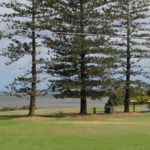Development schemes for the Toondah Harbour and Weinam Creek Priority Development Areas (PDA) ignored the loss of greenspace, community greenspace needs and the SEQ greenspace deficit.
Across south east Queensland (SEQ) the amount of publicly accessible greenspace per person has fallen annually. It is now 20% less than it was in 2001. This decline is due to population growth and a lack of investment by Government in buying community greenspace.
Loss of greenspace is a regional problem
The SEQ region has always been poorly served with community greenspace. SEQ has about 1/3 of the greenspace of the greater Sydney region. This surprises most people but across greater metropolitan areas of both city’s (or is it “like with like”), Sydney has about 49% of its area locked into a greenspace network, whereas SEQ is a long way behind with about 18%. Unfortunately SEQ has much less greenspace than the other capital cities too.
Loss of greenspace has been a pivotal issue in regional planning for SEQ. It reached a crescendo in the mid 2000’s when the region’s community faced the
prospect of a 200 km wide city. The mooted sale of GJ Walter Park rates as a significant loss of greenspace in SEQ.
Another sobering measure is that Brisbane itself is poorly served with parks. It has the least amount of parkland within 5km of the city centre of all the nations capitals.
All up the regions greenspace report card reads “failing and must do better”.
PDA planning was in denial
Given these problems the collaborative planning for the Toondah Harbour Priority Development Area is in denial. To incorporate the GJ Walter Park in the development footprint never made sense. It took no account of existing use or users, it had no regard to the existing amenity or the community benefits derived from the GJ Walter Park and it never considered the regional deficiency of greenspace.
The attempts to “sell off” or “give away” any part of GJ Walter Park or the adjacent public waterways of Moreton Bay were at odds with the overwhelming local and regional needs. If anything, the PDA planning seems to have been made in a vacuum.
The public uproar over the draft PDA Scheme, which had proposed the sale of the GJ Walter Park and massive development of the public foreshores and waterways, caused
back tracking by both Council and the State Government. Belatedly, the Council announced it “was listening to the community”. It made a commitment to keep the park or ensure “no net loss”, it reduced the maximum building height (from 15 to 10 storeys) and halved the wet berths of the marina to 400. In other words it was not the planners or the planning process that foresaw the problems. It took community action and community rancor to bring this “planning issue” to a head. No matter what your view of the PDA proposal , given what the official planning process delivered and its arbitrary intervention by Council does not augur well for the PDA planning process. If Government planners considered economic viability of the Toondah PDA required 15 storey and 800 berths, how can it now be viable with less.
Even now, how council will acquit the ”no net loss” of greenspace undertakings are not clear. Council needs to show how it will reconcile the area of greenspace, setting, uses and users. To date there seems to be no assessment of the current use or users. What we have seen to date is a greenspace planning process that has no regard to consequences. For example, the high rise development “enabled” in the PDA Precinct will be dependent on the existing GJ Walter Park for community greenspace. This would be an inadequate area of greenspace for the estimated population of the PDA, which could be near to that of Raby Bay.
But the expected high rise occupants of the PDA are not the only users of the Park. There are the existing users and residents to be accommodated. Then there are new residents of the new developments already under construction nearby. Then there is the existing and growing need to share the Bay’s foreshores with the rapidly increasing population of the SEQ region.
After the formal PDA community consultation, there was an arbitrary and undocumented process to adjust the PDA Schemes to “stop” the loss of parkland. But the impact of these changes on the economic parameters were never made public. Some suggest there was no assessment, just an political fix.
Toondah’s foreshore greenspace serves more the whole region
It comes as no surprise to locals that many people already travel a long way to access the foreshores of Redland City. More people will come. The current crowding of Cleveland or Wellington Point, on any weekend, is self evident. So on this issue the PDA planning could be described as “planning in a bottle”. It has ignored the land uses and pressures all around…like Cleveland CBD, NSI, Cleveland Point, Raby Bay, existing traffic constraints, RAMSAR, Moreton Bay Marine Park and more.
These local and regional greenspace dilemmas are not new. The issues are part of a basic approach to land use planning. How did it escape notice of the PDA planners?
A proper, fundamental and a competent approach to greenspace planning seems to have never been deployed. The myopic planning deployed for the PDAs completely missed the broader greenspace constraints and community needs. Given the poor greenspace planning evident for the PDA, the community angst for the possible loss of the nearby greenspace known as Linear Park is understandable. The decision seems to be being made in isolation from the Toondah proposals…how can that be?
Let us hope that greenspace planning in the City Plan 2015 does a better job than that used for the PDAs!
Please note: Offensive or off-topic comments will be deleted. If offended by any published comment please email thereporter@redlands2030.net


4 Comments
Defining Open Space: If the Pradella 460 units at West End is going to be allowed to count publicly accessible streets and pathways as part of its greenspace or parkland requirements ,according to a B.C.C. spokesperson, then what does that mean for units going up in the PDA precinct?
Greenspace planning? The Lawn Terrace tree clearing at Valantine Park, Division 8, to try to tell the little creatures where to live is a reminder that sufficient space has to be left between flying fox habitat and residentiai areas.
“Where will the children play?”
Studies have shown our health and wellbeing is improved if we get outdoors. As technology continues to advance and bring us indoors for more hours every day, the need for us to get outdoors increases. To get outdoors open space that we can all access and enjoy by ourselves and with family and friends is needed. Please make sure ALL, not just part, of the GJ Walter Park is retained for our childrens’ children. Thank you.
Prospective PDA developers have received the following advice: “A development application may propose something which is different to the PDA-wide criteria or Precinct provisions, in the development scheme, provided it is not inconsistent with the vision. This is intended to provide an appropriate amount of flexibility for alternative options to be lodged and considered.”
So if a developer wants to have a greater impact on G.J. Walter Park than is provided for in the approved development scheme the Council and Government can consider this.